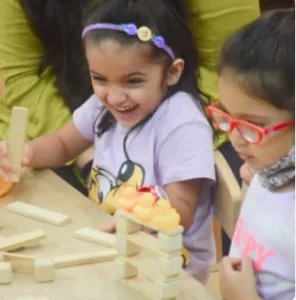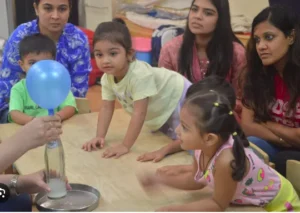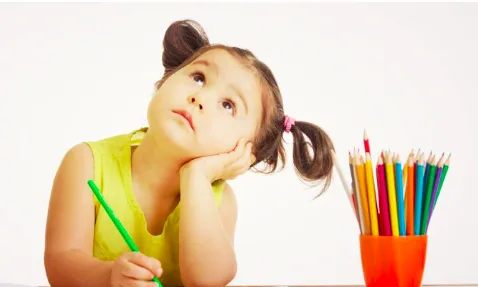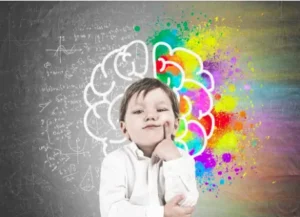Mathematics often has a bad reputation, even among adults. But the truth is, when introduced in the right way, math can be exciting, creative, and even joyful. For young children, especially between the ages of 2 and 6, early exposure to math fun for kids can build a strong foundation, improve problem-solving skills, and eliminate the fear commonly associated...
Do All Kids Need Right Brain Development Classes? Let’s Try And Decode This Step By Step
“Am I missing out if my child isn’t enrolled in right brain development classes?”
It’s a question many parents ask themselves, especially when they scroll through reels of genius toddlers solving puzzles, reading early, or painting like prodigies. The fear creeps in- “Are other kids ahead?” “Am I doing enough?” “Should I sign up for those right brain development classes?”
If you’re feeling this way, you’re not alone- and you’re not failing. Every child develops at their own pace, and the goal isn’t to pressure or rush that growth. Instead, the key lies in understanding how your child’s brain works and how to support it in a healthy, holistic way.
Let’s break it down together, step by step.
What Is Child Development?
Child development refers to the physical, emotional, cognitive, and social changes that occur from infancy through adolescence. These changes are not just milestones on a checklist- they’re foundational layers that shape your child’s ability to think, feel, relate, and learn.
During the early years, especially from birth to age 7, the brain develops more rapidly than at any other time in life. Neural pathways form at lightning speed, shaping how a child understands language, forms emotional bonds, responds to music, or interprets their environment.
To understand how development happens, it’s useful to look at the brain itself. The brain is divided into two hemispheres: the left brain and the right brain. While they work together, they have different strengths, and understanding those can help you make more informed decisions for your child.
What Does The Right Brain Do?
The right brain is the hub of creativity, imagination, intuition, visual memory, rhythm, and big-picture thinking. It’s where we process emotions, empathize with others, appreciate art and music, and form gut instincts.
Here are some core abilities linked to the right brain:
- Imagination and creativity
- Visual and spatial awareness
- Emotional understanding
- Intuition
- Holistic thinking
- Rhythmic and musical sensitivity
- Photographic memory (in early childhood)
Importantly, research shows that the right brain develops earlier than the left. Between birth and around age 3–4, children are naturally more right-brain dominant. This is why toddlers are so imaginative, absorbent, emotional, and curious; they’re wired to take in the world in a rich, holistic way.
Right Brain vs. Left Brain: Do Kids Need Both?
Absolutely. Both the right and left sides of the brain are essential, and they work best when they’re developed in balance.
The right brain governs creativity, emotion, visual memory, intuition, rhythm, and imagination. Children use it when they’re painting, listening to music, imagining stories, recognizing patterns, or connecting emotionally with others.
On the other hand, the left brain is all about logic, structure, and order. It’s responsible for language, numbers, reasoning, sequencing, and analytical thinking. This side of the brain becomes more dominant as children grow older and begin formal schooling.
So do kids need both? Yes. The right brain helps children feel, see the bigger picture, and create, while the left brain helps them process details, communicate, and solve problems. When developed together, they create a foundation for holistic learning, where a child is both imaginative and articulate, expressive and analytical.
Most traditional schools and academic programs tend to lean heavily on left-brain skills like reading, writing, and maths. That’s why many parents are now turning to right brain development classes- to ensure their child’s creative and emotional side is equally supported.
What Are Right Brain Development Classes?

Right brain development classes are designed to stimulate the brain during its most absorbent years. These are typically structured programs for children aged 6 months to 7 years, and they focus on enhancing abilities like photographic memory, visualization, speed listening, pattern recognition, empathy, and more.
Here’s what these brain development classes for kids usually involve:
- Flashcards shown at high speed – to enhance processing speed
- Storytelling and audio stimulation – to nurture imagination and intuition
- Linking memory games – to develop association and recall
- Mandala and puzzle exercises – to enhance pattern recognition
- Music and rhythm-based activities – to boost auditory processing and emotional regulation
- Breathing and meditation – to increase attention span and self-awareness
These sessions are short, dynamic, and playful, often designed to feel like a game, not a classroom. The idea isn’t to replace traditional learning, but to add a layer of brain enrichment in a child’s most receptive years.
Do All Kids Need Right Brain Classes?
Now comes the core question: Is it essential?
The honest answer: Not necessarily.
Right brain skills are naturally developed through rich experiences like play, music, art, nature walks, reading, and loving interactions with caregivers. Children who engage in these activities regularly may already be developing their right brain without ever stepping into a classroom.
Let’s normalize this: Not every child needs to be in a structured program to thrive.
That said, right brain development classes can offer:
- Consistent, focused stimulation
- A distraction-free learning space
- Exposure to techniques parents may not know
- Group interaction benefits
So while they aren’t mandatory, they can be an incredible extracurricular class for kids, especially when tailored to your child’s pace, interest, and needs.
Signs Your Child Might Benefit from Extra Support
Some children are naturally drawn to structured stimulation, while others need more help focusing or expressing themselves. Here are signs that extra classes for kids might be helpful:
- Difficulty concentrating or remembering instructions
- Trouble expressing emotions
- Resistance to traditional classroom learning
- Tendency to withdraw or act out
- High curiosity and energy that feels under-stimulated
- Strong artistic or musical interests that need nurturing
If you notice these, a right brain development class might offer a positive outlet and boost confidence.
Practical Ways To Support Right Brain Development At Home

You don’t need a fancy setup to encourage right brain growth. Here are easy and effective ways to nurture it at home:
- Play soft background music (especially classical or instrumental)
- Tell visual-rich stories and ask your child to imagine the scenes
- Play matching or memory games
- Engage in pretend play (chefs, doctors, space explorers!)
- Create art together with crayons, paints, sand, or even food
- Practice simple mindfulness through deep breathing
- Let them move– dancing, hopping, and swinging stimulate brain-body connections
Remember, what looks like play to us is often learning at its deepest for children.
Addressing Common Anxieties and Misconceptions
Let’s address some thoughts that often swirl in parents’ minds:
- “Will my child fall behind without right brain development classes?”
Not if they’re getting rich experiences, love, and engagement at home or school. - “Is my child too old to benefit?”
While the most absorbent window is 0–7, it’s never too late to stimulate creativity and emotional intelligence. - “Will right brain development harm left brain skills?”
Nope. In fact, developing the right brain enhances memory, comprehension, and creative thinking, all of which support academic skills. - “If my child doesn’t show signs of giftedness, is it too late?”
Not at all. These classes aren’t just for genius-making. They help build confidence, emotional regulation, and joy around learning .
FAQs
Do right-brain classes improve academic performance?
They can contribute indirectly. While they don’t replace academic tutoring, they build core skills like memory, focus, and creativity, giving kids a strong foundation for academic success.
Can right-brain skills be developed without classes?
Yes. With a nurturing, interactive environment and mindful activities, right brain skills can flourish naturally. Still, right brain development classes offer structure and consistency some parents find helpful.
At what age is it best for right brain development activities?
The ideal window is from 6 months to around 7 years, when the brain is highly absorbent and neuroplasticity is at its peak.
Conclusion: What Matters
So, do all kids need right-brain development classes?
Not all. But all kids benefit from right brain stimulation. These classes are a tool, not a requirement. If you’re drawn to them, they can be a wonderful part of your child’s developmental journey. If not, don’t stress. You are your child’s best teacher, guide, and cheerleader.
What matters most is being present, paying attention, and allowing your child to unfold in their own unique way.
If you’re curious to explore more, consider attending a free Tickle Right orientation. Sometimes, a small experience can show you just how big your child’s potential really is.


